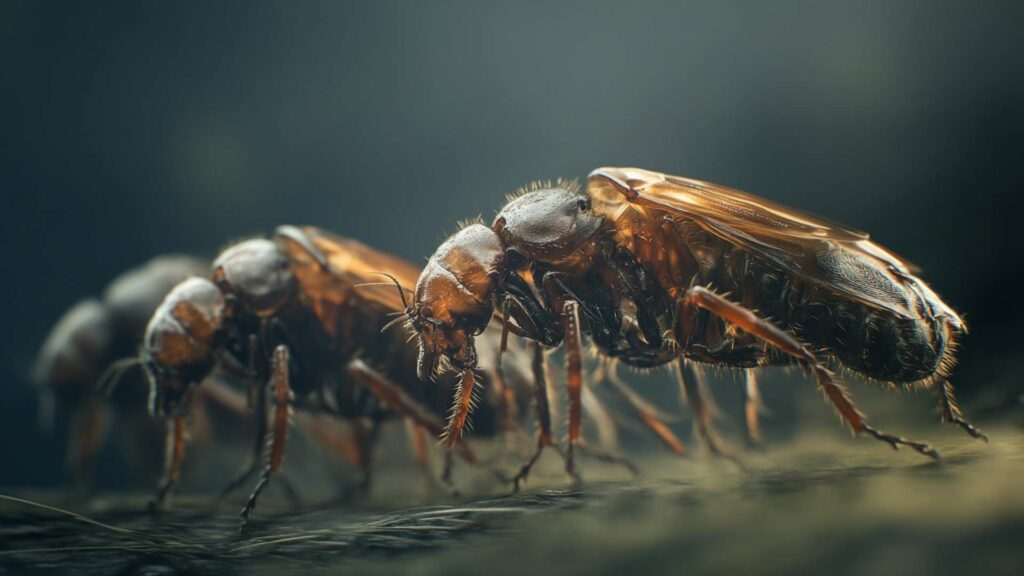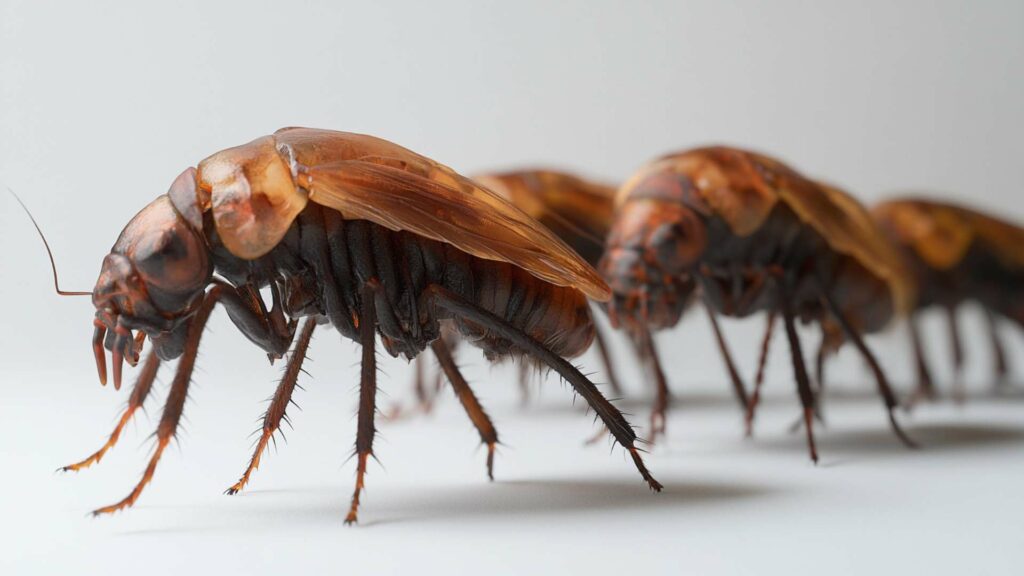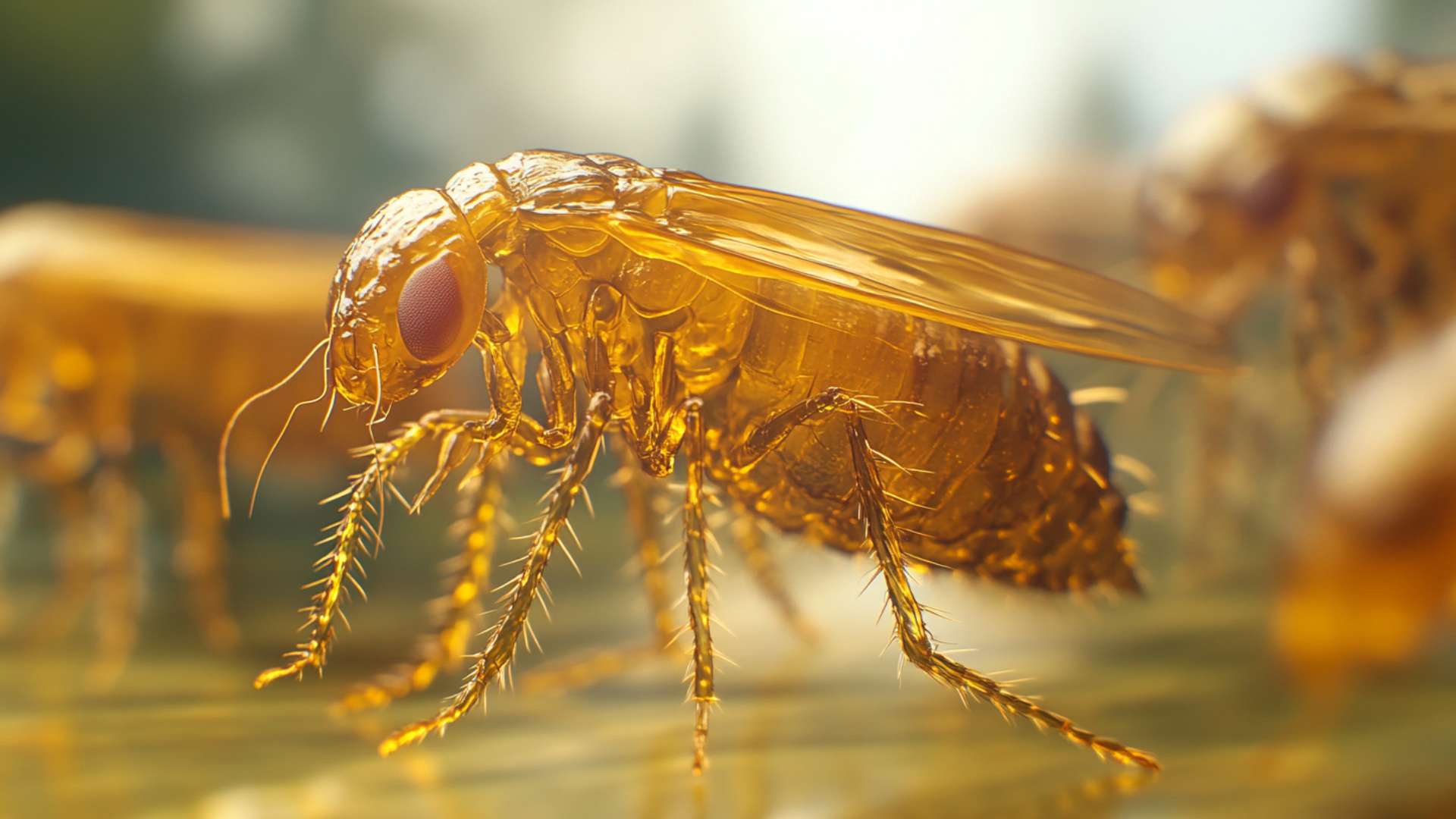Imagine this: you’re relaxing on the couch, having a calm evening, when a small intruder appears. Yes, I’m talking about fleas. They are tiny pests that can cause trouble for our house, our pets, and us.
But what exactly are fleas, and why do they always seem to have unwelcome companions? Let’s explore how fleas are connected to other animals and find small others in their fascinating world.
Definition of fleas and their characteristics: Fleas are wingless insects that belong to the order Siphonaptera. These pesky critters are very small, measuring only about 1/16th to 1/8th of an inch in length.
Even though they’re small, these blood-sucking parasites are powerful! Don’t underestimate them! Fleas have mouthparts made for biting into the skin of animals and sucking their blood.
Other animals often have fleas too, not just cats and dogs. Cats often have cat fleas (known as Ctenocephalides felis), while dogs often have dog fleas (Ctenocephalides canis).
But, let’s not forget that other creatures can also fall prey to these tiny terrors. Fleas can attach to many animals, including rabbits, rodents, foxes, and coyotes. This causes itching and discomfort for other family pets.
Next time you scratch your dog’s back or treat your home for fleas, remember that fleas can live on many hosts. Now, let’s learn more about fleas and the animals they bother. We’ll explore their body, life cycle, and the problems they cause.
Fleas are small blood-sucking pests that have developed physical adaptations to survive. These adaptations help them thrive in their parasitic lifestyle. Let’s delve into the minute details of their anatomy. Fleas have a tough outer shell that protects them from outside forces.
The exoskeleton keeps them safe and prevents dehydration in dry areas. Fleas have strong legs that help them jump very far and land on animals or humans.
Their mouthparts are another marvel of nature. Fleas feed by piercing the skin with a tube like a needle and sucking blood.
The mouthparts can pierce the skin and secrete saliva with anticoagulants and anesthetics. The anticoagulants stop blood from clotting. The anesthetics make sure hosts don’t feel pain.
Can Cats Get Fleas from Dogs? Navigating Flea Transmission Between Pets
Explore the dynamics of flea transmission between pets as we address the question, Can cats get fleas from dogs?. Gain insights into how fleas move between different animals and learn effective strategies for preventing and managing flea infestations in multi-pet households.
Can Rabbits Get Fleas? Understanding Flea Risks for Your Bunny
Discover the potential risks as we answer the question, Can rabbits get fleas?. Delve into the unique challenges of flea infestations in rabbits, including symptoms to watch for and safe treatment options. Ensure the well-being of your furry friend by staying informed about flea prevention.
Can Ferrets Get Fleas? Unraveling Flea Concerns for Ferret Owners
Ferret owners, learn about the risks and solutions related to fleas with insights into the question, Can ferrets get fleas?. Understand the specific challenges posed by fleas in ferrets, from potential health issues to preventive measures. Keep your ferret happy and healthy with effective flea control.
Can Wildlife Carry Fleas? Exploring Flea Risks in the Wild
Delve into the wild side of flea infestations as we answer the question, Can wildlife carry fleas?. Understand how fleas impact wildlife populations and the potential implications for domestic pets. Gain insights into the interconnectedness of flea ecosystems and the importance of holistic flea control.
Do Fleas Affect Birds? Examining Flea Impact on Avian Health
Bird enthusiasts, discover the nuances of flea impacts on birds with insights into the question, Do fleas affect birds?. Learn about the potential harm fleas can cause to avian health and explore strategies for maintaining a flea-free environment for your feathered friends.
Life Cycle of Fleas – From Egg to Adult Flea
To combat fleas, it’s crucial to understand their life cycle. Let’s take a closer look at their fascinating journey from egg to adult flea.
1. Egg Stage: Female fleas lay eggs on their host animals’ fur or bedding. The small eggs are oval-shaped and can be white or see-through. They are very hard to see. The tiny eggs hatch into larvae in one to twelve days, depending on the environment.
2. During the larval stage, flea larvae look like worms and have bristles on their bodies. They have small mouths for eating flea feces and dead skin cells. They usually hide in dark, warm, and humid places like carpets, pet bedding, and soil. In this stage, larvae molt many times. Then they spin a cocoon and become pupae.
3. Larvae transform into adult fleas during the pupal stage. They do this inside protective cocoons called pupae. Pupae are tough and can live in many places, so they’re not easy to get rid of. The insects can stay in their cocoons for many months. They come out when they feel vibrations or high levels of carbon dioxide.
4. When the flea becomes an adult, it comes out of its cocoon and looks for a host to feed on. These tiny vampires can quickly infest cats and dogs or even latch onto humans in proximity. Once they find a suitable host, they mate and begin the reproductive cycle anew.
Compared to their constant biting and annoying habits, flea reproduction may seem unimportant. However, understanding their reproductive capabilities is vital in curbing infestations effectively.
Female fleas are amazing because they can lay 20-50 eggs every day! If the conditions are good, the eggs hatch in two days. This means an infestation can spread quickly.
Furthermore, fleas exhibit remarkable resilience when it comes to population growth. Only 5% of fleas are adult ones on animals; the rest hide as eggs, larvae, or pupae in homes or outdoors.
Just getting rid of adult fleas won’t solve the flea problem forever. You also need to deal with the flea eggs and larvae in carpets, furniture cracks, and pet bedding areas. Knowing how fleas reproduce and their population dynamics helps us fight infestations effectively. We can use targeted prevention and treatment strategies based on these facts.
Dogs: Understanding the impact of fleas on man’s best friend

Dogs, our faithful friends, are not immune to pesky fleas that bother them. Certain dog breeds are more likely to get flea infestations than others, but all dogs can be affected. Certain breeds of dogs, such as Pomeranians, Siberian Huskies, and Collies, can conceal signs of fleas because of their long, thick fur.
The fur is thick, so fleas can hide well and are difficult to find and remove. On the other hand, short-haired breeds like Boxers and Dalmatians are not entirely immune to fleas either.
Fleas can easily cling to their fur during walks or outdoor activities. Regardless of the type of dog or how long its fur is, it’s important for owners to protect their pets from fleas.
Fleas on dogs can be more than just annoying – they also pose health risks. These parasites suck blood and can make our pets sick.
When a flea bites a dog, it injects saliva that can trigger an allergic reaction in some animals. Flea allergy dermatitis (FAD) can make pets very itchy and cause hair loss. It can also lead to skin infections and hot spots.
Fleas can give you tapeworms, infestations, and cat scratch disease (Bartonella infection). Pet owners must be proactive to prevent these tiny pests from infesting their dogs.
Regular grooming is important. It helps find and treat fleas early and keeps skin healthy. Using the flea treatment and prevention products recommended by vets can effectively protect dogs from parasites. These products include spot-on treatments and flea collars. They help keep parasites away and ensure the dogs’ well-being.
Cats: Unraveling the mysteries of feline flea infestations
Cats are famous for grooming themselves, but even they can get fleas sometimes. Some cat breeds are more likely to get these parasites than others, but all can be affected. Persians and Maine Coons have long hair, which attracts fleas to hide and multiply.
The thick fur keeps the body warm and protected. This makes the itchy skin a perfect home for fleas to live unnoticed. Outdoor cats are more likely to get fleas than indoor cats.
Cats that go outside or play with other animals are more likely to get fleas. Cat owners must understand that no breed is completely immune to fleas. They should remain vigilant regardless of breed or lifestyle.
Grooming is important for cats to prevent fleas. It helps maintain their appearance and stops infestations. A cat’s tongue has tiny hooks that help it groom precisely and efficiently.
When a cat cleans its fur carefully, it gets rid of any fleas that might try to hitch a ride and live on its body. Brushing regularly spreads natural oils on the fur and removes loose hair. Loose hair might have flea eggs or pupae.
You can strengthen your bond with your cat and prevent fleas by brushing them gently. To keep your cats safe and healthy, groom them often and use flea treatments recommended by the vet.
Unexpected Hosts: Other Animals Affected by Flea Infestations

When we think about fleas, our minds often jump to the annoyance they cause our beloved family pets. But, we must remember that these bothersome parasites generally don’t choose who they infect. Wildlife species can also fall victim to flea infestations, with potentially dire consequences.
Fleas pose a significant threat to the health of wild animals. When fleas attach to a rabbit’s fur and feed on its blood, it can cause the rabbit severe anemia and weaken its immune system.
This makes them more susceptible to other diseases and infections. When animals get bitten by fleas, they might itch a lot. This itching can hurt their skin and make it bleed, which is not good for them.
Fleas bother animals and transmit diseases to different animal groups. These small parasites carry diseases like bacteria and protozoans. Cat fleas, like Ctenocephalides felis, are well-known for carrying Bartonella henselae bacteria. These bacteria cause cat scratch disease in humans, birds, and other mammals.
Infected animals unintentionally spread disease-causing organisms when they carry fleas to new areas. This transmission is a big threat to wildlife. It can also harm human health if people touch infected animals or dirty places.
Impact on conservation efforts and ecosystem balance
Fleas can cause problems for more than just one animal’s health. They can also disturb whole ecosystems. Introducing fleas can worsen the situation for species already vulnerable or facing extinction.
Fleas can cause serious problems for small mammals like mice or voles. These problems include poor health and fewer offspring. This can push these already threatened species further towards extinction.
In addition, fleas help balance ecosystems by controlling some animal populations naturally. Fleas can control animal populations when there are many animals and little food or predators.
Tiny terrors: Small mammals plagued by fleas
While fleas are often associated with dogs and cats, small mammals are not exempt from these tiny terrors. Mice, rats, rabbits, and squirrels often have fleas because they live near people and have lots of food.
The hidden world of flea-infested rodents is one that we rarely see but is nevertheless significant. These rodents provide ideal environments for fleas to thrive due to their warm fur and constant supply of blood.
If you see live fleas or signs like bite marks, itching, or adult fleas, be cautious. It’s vital that we acknowledge the implications these flea-infested small mammals have on public health as well.
Rodents are known carriers of various diseases such as plague and hantavirus. By controlling fleas on these animals, we protect ourselves and keep the ecosystem healthy.
Flea Control Measures for Humans and Animals
Dealing with a flea infestation in your home can be an itchy nightmare. However, there are effective strategies you can employ to combat these pesky parasites. To get rid of fleas, it’s important to clean everything carefully. Vacuum all carpets, furniture, and bedding to remove eggs and baby fleas.
After using the vacuum, throw away the bag or empty the canister outside right away. This will stop any fleas from coming back into your home. You can use natural remedies or chemicals to treat flea dirt in your home. Both methods work well.
You can use diatomaceous earth to dry out fleas. Essential oils like lavender or eucalyptus can also repel them. There are chemical treatments that can get rid of fleas, like sprays or foggers. Pyrethrins are insecticides that can be easily found. These treatments are usually stronger and can effectively end flea infestations.
Natural remedies vs chemical treatments – pros and cons
Before you choose between natural remedies and chemicals for flea control, consider the pros and cons. Many people prefer natural remedies to reduce chemical use in their homes. These products are safer for families with young children or pets who may touch treated surfaces.
Natural remedies may not completely get rid of fleas like chemicals can. Chemical treatments are strong and can kill fleas in all stages of their life cycle. This gets rid of the infestation completely.
Be cautious when using chemicals near other pets, as they can harm them if used incorrectly. When deciding between natural remedies and chemical treatments, your veterinarian and personal preferences are important. You should also consider the severity of the infestation and any potential risks.
Proper sanitation practices to prevent future infestations

To stop more fleas, keep your home and surrounding areas clean and tidy. Washing bedding, blankets, and pet bedding in hot water kills fleas and their eggs.
To avoid fleas, regularly vacuum carpets, rugs, and furniture to get rid of where they hide. To reduce fleas, regularly mow the lawn and trim the grass outside the pet and house.
Flea larvae tend to avoid direct sunlight and thrive in shady areas with high humidity. By keeping the yard well-maintained, you can discourage fleas from establishing themselves.
Protecting pets from pesky parasites
Our furry friends are often susceptible to flea infestations. To protect your animals from these annoying parasites, regular grooming is key.
Brushing your pet often removes adult fleas, their eggs, and ticks or other parasites in their fur. Additionally, keeping pets clean with special shampoos can get rid of fleas and stop new ones.
To keep cats and dogs flea-free, give them special treatments every month. These products kill adult fleas and stop them from laying eggs, preventing more fleas.
Conclusion
To get rid of fleas and keep our pets safe, we need to be diligent and use effective strategies. When dealing with an infestation, people consider their preferences, effectiveness, and potential risks.
To stop fleas, we need to keep everything clean inside and outside. This will make it hard for fleas to survive. By taking these steps, you can have a home without fleas and still enjoy your pets.
Frequently Asked Questions:
Animals like dogs, cats, and rodents are often infested with fleas.
Fleas are attracted to various animals, including dogs, cats, rabbits, and rodents.
Fish and reptiles are examples of animals that are less likely to get fleas.
To address fleas without pets, focus on thorough cleaning, vacuuming, and using flea control products for the environment.








